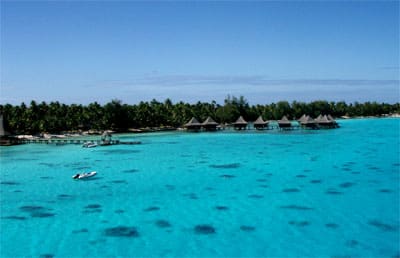To the editor: The Pacific basin is an iconic tourist destination, and for good reason. Any voyager who has spent time there can attest to its beauty and diversity: the Tuamotus’ palm-fringed atolls, Fiji’s lush rainforests, and New Zealand’s vertiginous fjords. Tourist-based development in the area is equally diverse. The only way to visit the Maskelyne Islands in Vanuatu is on your own cruising boat, while high-rise hotels crowd Australia’s Sunshine Coast.
The tiny Micronesian island of Yap may be the latest to transition from one extreme of the tourism industry to the other. The cruising sailors’ website www.noonsite.com describes Yap as having “one of the most distinctive cultures in the Pacific” in which legends are passed down through dances. But if Chinese developer and multimillionaire Deng Hong succeeds in his plans, “the most intriguing island in Micronesia” will be transformed into a massive casino and golf resort. Mr. Deng’s company, Exhibition and Travel Group (ETG), anticipates that the 4,000-room complex will bring a million tourists a year to the 39-square-mile coral speck. That’s quite an increase on the 4,000 scuba divers, voyagers, and other intrepid souls who visited Yap in 2012.
Arguments can be made for and against the proposal. American subsidies to the Federated States of Micronesia, begun after World War II and scheduled to end in 2023, have mostly propped up an inefficient bureaucracy, which has often hindered rather than helped independent economic development. Mr. Deng claims his resort will boost Yap’s economic output from $50 million to $200 million. He says he will build a deeper port, longer airstrip, and new schools. On the other hand, many Yapese don’t wish to see their island become a Chinese holiday destination. They fear the total erasure of their 3,000-year-old culture. The development will segregate the island into tourist areas and a “native town community,” filled with apartment blocks to house the displaced islanders. Ancient links with ancestral villages could be broken. Opponents of the development also claim that the 99-year leases ETG has extracted from Yapese property owners have low rents that diminish as the years go on.
I believe the Yapese are right to be apprehensive. On my global circumnavigation with my husband Seth aboard our 38-foot cutter Heretic, I saw many forms of tourism and the different impacts they had. French Polynesia, despite its poetic beauty, received only 154,000 arrivals in 2010. Bora Bora, a favorite Polynesian island for tourists and voyagers alike, has been discreetly developed with small hotels (none larger than about 150 rooms). The locals still race outrigger canoes on a lagoon that remains theirs. Yet they also benefit from the influx of foreign money. They run dive shops, restaurants, souvenir stores, and B&Bs. Thanks to the relatively low number of visitors, the physical environment remains healthy as well. Forest still dominates the central mountainous island, and the lagoon’s coral grows in a healthy purple carpet. The waters teem with reef fish, manta rays, and lemon sharks.
When Seth and I left Heretic in South Africa for a short trip over land to Ponta do Ouro in Mozambique, however, we found the coral broken and dead from the blundering kicks of far too many visitors. Five or six groups of 15 scuba divers each would converge on a site at a time. Ashore, things were even worse. A sprawling camp and resort had taken over the beach. People roared around the sand on ATVs. Jet skis whined over the waves, a hazard to swimmers and divers. The Mozambican residents were completely overshadowed, reduced to cleaning bathrooms and hawking beautiful wooden carvings for pitifully small prices.
It seems that a similar fate awaits Yap under the pressure of a million annual tourists. Its culture and its environment will suffer in ways that places like the Tuamotus and Bora Bora have avoided. On Bora Bora’s neighboring island, Huahine, Seth and I were the only strangers to attend a traditional dance that was part of a festival for the islanders, not a tourist attraction. Will the ancient art of dancing on Yap withstand the pressure to become a mere show at the casino complex? Responsible development in Polynesia has also maintained the health of both forests and coral reefs, but Mr. Deng’s golf course could very well upset a number of ecosystems, potentially destroying fragile mangroves and smothering the coral with murky run-off. I also wonder how such a strong Chinese influence in the area might affect Micronesia’s current efforts to ban shark fishing. The lucrative business is hard to prevent, even in protected marine areas like the Galápagos Islands.
No matter how responsibly it is implemented, tourism will always have negative side effects. Even on Bora Bora, some locals resent the affluence of resort-goers. Inevitably some tourists and even voyagers are badly behaved. But places like the Tuamotus and Bora Bora, by opting for high-end, expensive tourism, have effectively limited their number of visitors. This has ensured the maximum benefit for locals while minimizing the downsides of the industry. French Polynesia is perhaps able to do this more easily because of French subsidies, but the Cook Islands and much of Fiji have followed suit. With Yap’s American subsidies to end in 10 years, the island will need to find a plan for financial independence. But as other Pacific islands have shown, there are much less invasive blueprints for tourist development, methods that might preserve both Yapese culture and the island’s pristine environment while still providing economic opportunity. For my part, I can only hope the Yapese are successful in opposing the development tycoon.
—Ellen Massey Leonard and her husband Seth circumnavigated aboard their 38-foot sloop Heretic. She currently lives in Concord, N.H.

